
The tech landscape of 2023 unfolded with unexpected excitement, unveiling the next-gen ROCK 5 and the release of the long-awaited Raspberry Pi 5. It sparked the interest of tech-savvy enthusiasts who eagerly waited to get their hands on the boards and begin developing unparalleled, innovative projects. So, to help you decide on the right board for your specific project, we asked Peter Milne, an engineer and Linux advocate, to take the reigns and review their tech specs and performance.
Explore this Raspberry Pi 5 review and discover how its tech specs compare to the next-gen Radxa ROCK 5A, a perfect Pi 5 alternative. Let’s dive into the heart of SBC innovation!
Author: Peter Milne, engineer and Linux advocate with probably more SBCs than a Chandrayaan-3 moon lander.

2023 was an exciting year for Single Board Computers, first with the release of the next-gen ROCK 5A from Radxa, followed by the launch of the Raspberry Pi 5.
Both boards provide a step up in performance for credit card format SBCs, but as you would expect, you get far more for your money when you invest in the ROCK 5A.
In this review, I tested the ROCK 5A and the RPi5 to show you why.
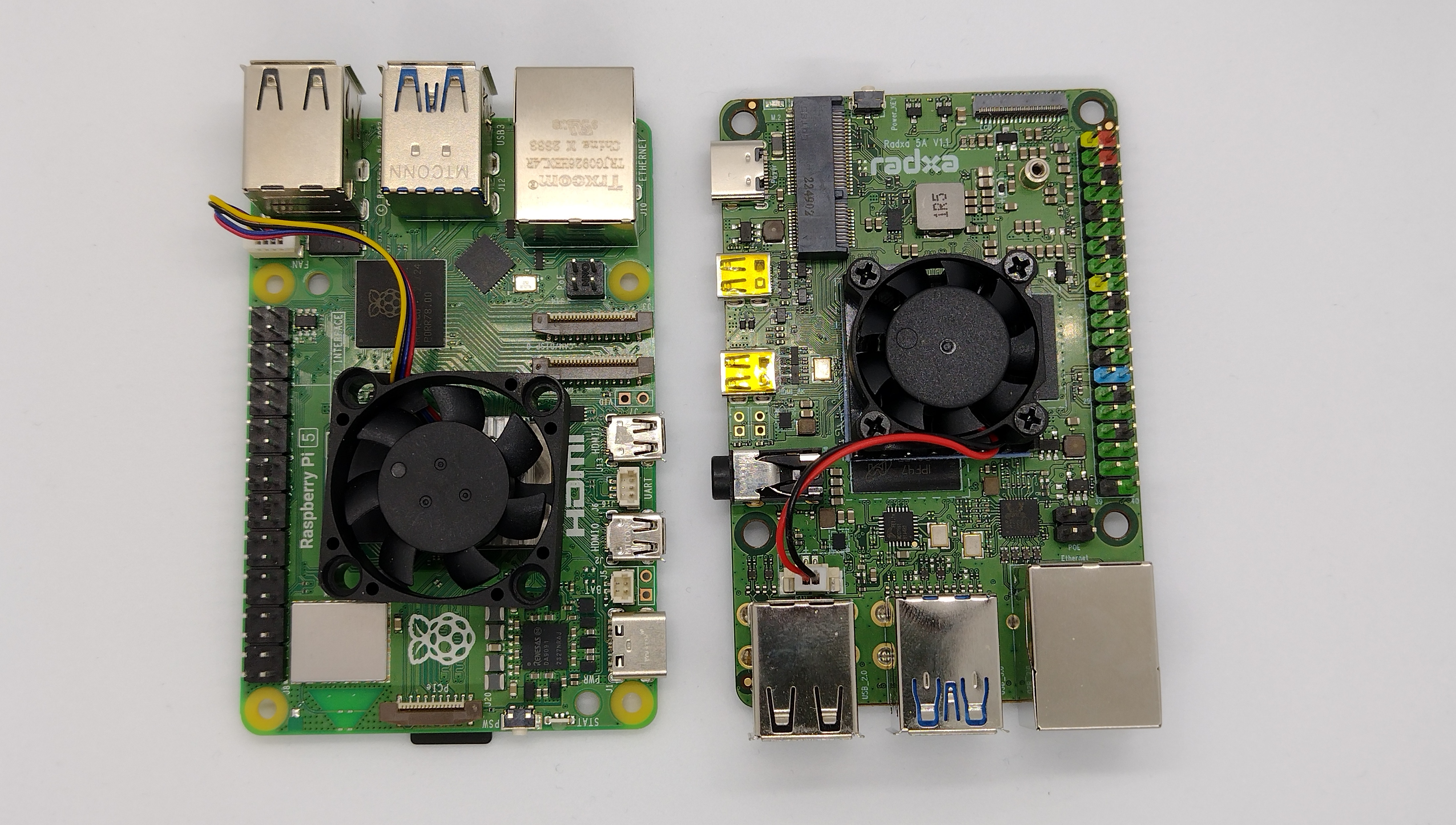
Technical Specifications
Here are the specs:
| ROCK 5 Model A | Raspberry Pi 5 | |
| SoC | Rockchip RK3588S | Broadcom BCM2712 |
| Processor | 8-core 64-bit (Arm® DynamIQ™ 4×Cortex®-A76+4×Cortex-A55), 8nm lithography process, frequency up to 2.4GHz | 4-core 64-bit (4x Arm Cortex-A76), 12nm lithography process, frequency up to 2.4GHz |
| NPU | AI Accelerator – 6 TOPS NPU 3.0 | N/A |
| GPU | Arm Mali™ G610MC4 GPU supporting OpenGL® ES3.2, OpenCL® 2.2, Vulkan® 1.2, Embedded high performance 2D image acceleration module | VideoCore VII graphics, with OpenGL-ES 3.1, Vulkan 1.2 |
| VPU | Video decoding: 8K@60fps H.265/VP9/AVS2 8K@30fps H.264 AVC/MVC 4K@60fps AV1 1080P@60fps MPEG-2/-1/VC-1/VP8 Video encoding: 8K@30fps encoding, support H.265 / H.264 | HEVC/H265 decode |
| Memory | 4GB / 8GB / 16GB LPDDR4x SDRAM | 4GB or 8GB LPDDR4X SDRAM |
| Power | USB Type‑C™ PD Version 2.0 Qualcomm® Quick Charge™ 2.0 Power adapter with fixed voltage in 5.2V to 20V range on the USB Type‑C port 5V Power applied to the GPIO PIN 2 & 4 | Raspberry Pi 27W USB-C Power Supply, which provides up to 5A current at +5.1V |
| HDMI | Dual micro HDMI output ports(Type D), both support CEC and HDMI 2.1 with resolutions of 8Kp60 and 4Kp60 | Dual 4kp60 HDMI display output with HDR support 4kp60 HEVC decoder |
| USB | 2x USB2 Type A HOST ports 1x USB3 Type A HOST port 1x USB3 Type A OTG/HOST port | 2x USB 2.0 2x USB 3.0 (capable of simultaneous full throughput) |
| Audio Ports | 3.5mm jack – stereo output/mic input | N/A |
| Connectivity | Gigabit Ethernet with PoE support M.2 E Key (Optional WiFi 6 + BT 5.2 Dual Mode) | Dual-band 802.11ac Wi-Fi® Bluetooth 5.0 / Bluetooth Low Energy (BLE) Gigabit Ethernet with PoE+ support |
| MIPI | 1x 4 lane MIPI CSI or 2x 2 lane MIPI CSI 1 x 4 lane MIPI DSI | 2 × 4-lane MIPI camera/display transceivers |
| Storage | Micro SD / eMMC / M.2 E key PCIe 2.0 x1 interface | Micro SD / PCIe 2.0 x1 interface |
| GPIO | 40-pin header incl 1 x CAN | Raspberry Pi standard 40-pin header |
| RTC | Yes | Yes |
| Power On/Of | Yes | Yes |
| Software | Debian / Ubuntu / Android 11/ Armbian / etc | Raspberry Pi OS / Ubuntu / LibreELEC / etc |
| Operating Temperature | 0~50 ℃ | 0~50 ℃ |
System on a chip (SoC)
Let’s start with the SoC, which is the biggest difference between the two boards.
Based around the Rockchip RK3588S SoC, the ROCK 5A has 8 Arm cores. 4x Cortex-A76 cores plus 4x Cortex-A55 cores using Arm’s big.LITTLE technology with DynamicIQ.
RPi5s Broadcom BCM2712 SoC has just 4 Arm Cortex-A76 cores, the same as the big cores in the ROCK 5A.

The RK3588S SoC also uses the most recent 8nm silicon die process compared to the BCM2712’s older 12nm lithography.
Arm’s big.LITTLE technology and DynamicIQ matches the compute load to the appropriate CPU cores. big processors are designed to provide maximum speed and sustained compute performance, while the LITTLE processors are designed for maximum power efficiency.
It’s this next-gen technology that gives the ROCK 5A more than 2x the performance of the RPi5 in heavy computing tasks and is the secret to its high power efficiency.
“The ROCK 5A is built for performance and has everything and more that you’d expect from a next-gen board.”
– Pete Milne
If you want to know more about how DynamicIQ works, watch this short video from Arm.
But how does this play out in real life? I put this to the test by giving both boards something to think about, loading up their cores to the max with some Python number crunching to see how long it took each device to complete a series of computationally intensive tasks.
Here’s the Python script I used. It runs a series of tasks, which in this case is the sum of the squares, in a separate Python process, allocating each one to the next available core, using a Multiprocessing Pool.
When one task completes, the next one is allocated from the pool until all the tasks are finished. This loads up all the CPU cores to 100% capacity with the sum getting larger and larger as the calculation progresses:
import sys, os, math
from multiprocessing import Pool
from datetime import datetime
def task(n):
return sum([i**2 for i in range(1, n + 1)])
num_cores = os.cpu_count() # Use all CPU cores
start_time = datetime.now()
with Pool(num_cores) as pool:
results = pool.map(task, range(40000))
print(f'Elapsed time: {datetime.now() - start_time}')
To make things as fair as possible, I installed Docker on each 4GB RAM system using the instructions on the Docker site. See the Docker Debian install here. Then, I built an image on each board before running the code in the containers.
This meant each board was running the same recent Python version, which should be optimised for the latest CPU hardware.
The images show the results, which as you’d expect, the ROCK 5A is more than 2x faster than the RPi5.
ROCK 5A performance result:

Raspberry Pi 5 performance result:

Although this is just one example, running Python computations in Docker and using process pools is a typical application in scientific computing, Machine Learning, image processing and IoT gateway applications, which these boards are suited to.
You can watch the whole process on video, which is a bit more exciting.
SD / eMMC
The Achilese heel of the Raspberry Pi has always been its reliance on SD cards to store the OS and data if you want to keep a compact physical footprint without having to add external storage via USB adapters.
Whilst SD cards are convenient during development, they are not really designed for use in SBCs for long periods, with frequent read/write cycles, which can damage them within a few weeks of use. They are also quite delicate, subject to vibration, and easily damaged, sticking out from the board’s edge.
You can use SD card media on the ROCK 5A, but you also have the option to run the OS from industrial-strength eMMC memory, which is designed for the purpose. This provides a faster, more secure and durable performance. The modules are attached to the underside of the PCB with a standard board-to-board connector for security and are available in 16GB / 32GB / 64GB / 128GB capacities. You can see the whole range of ROCK memory accessories here.
ROCK 5A with 16GB eMMC 5.1 module:
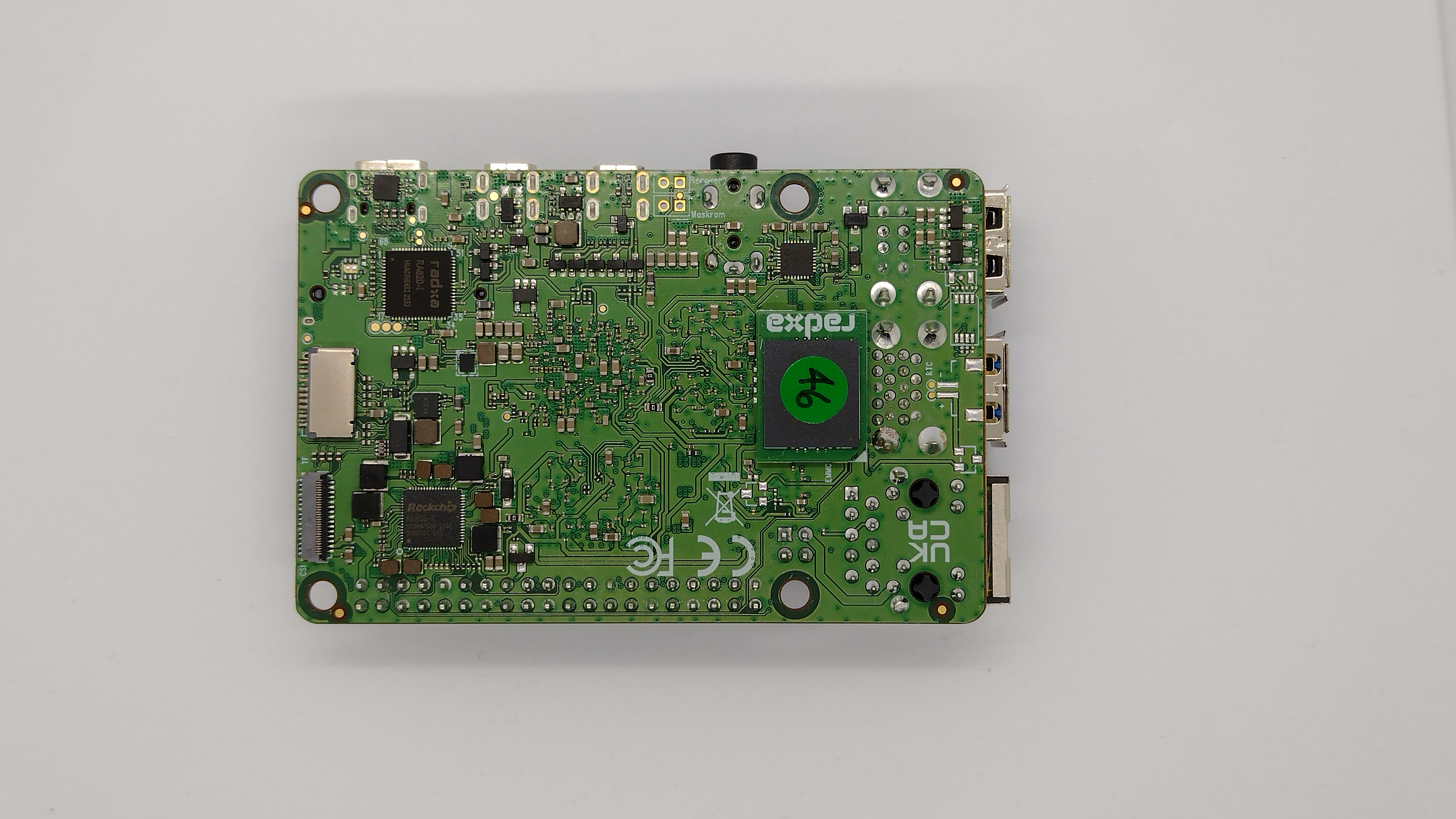
Raspberry Pi has significantly improved the SDIO performance of their SD interface on the RPi5, but it’s still nowhere near as fast as the eMMC performance on the ROCK 5A.
A read test with Hdparm shows the ROCK 5A to be nearly 3x faster than the RPi5, in addition to all the other benefits of eMMC media.
Raspberry Pi 5 with SD Card:
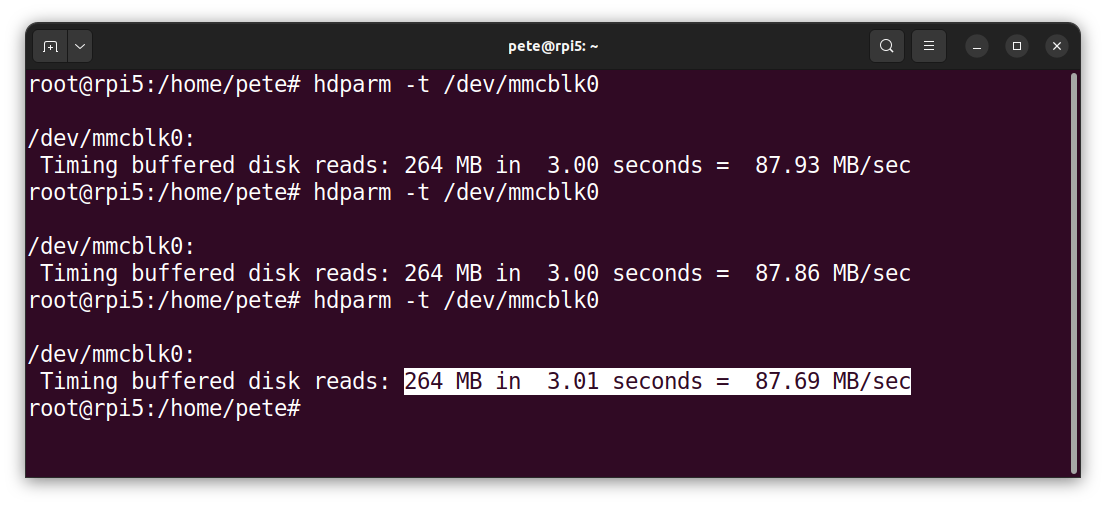
ROCK 5A with eMMC module:
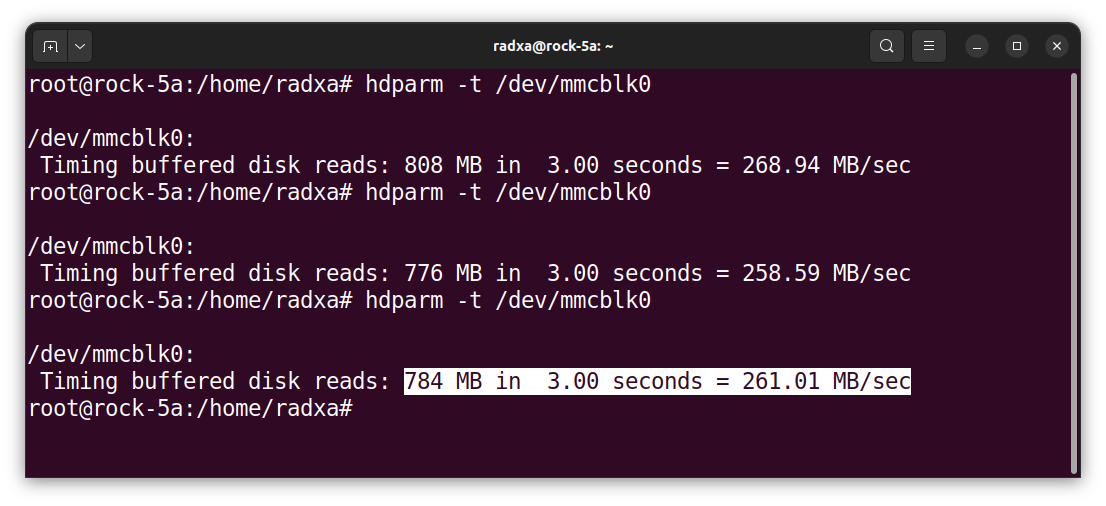
PCI Express / NVMe / M.2
Apart from the addition of the Power Button on the RPi5, which the ROCK 5A already has, there’s now the inclusion of a special PCIe connector on the board edge. This brings with it the hope that NVMe SSDs can be connected directly to the bus, allowing bootable, large-capacity, permanent storage. At the moment, though, Raspberry Pi hasn’t released the specification for this interface, so you can’t use it yet.
The ROCK 5A has a standard M.2 E-key PCIe slot on the top of the board, and Radxa produces a low-cost adapter board, allowing the attachment of NVMe SSDs in 2230/2242/2260/2280 formats. It comes with a 16MB SPI Flash Module that supports booting from NVMe SSD, USB Drive, SATA SSD/HDD using the adapters.
ROCK 5A with adapter and bootable 128GB NVMe SSD:
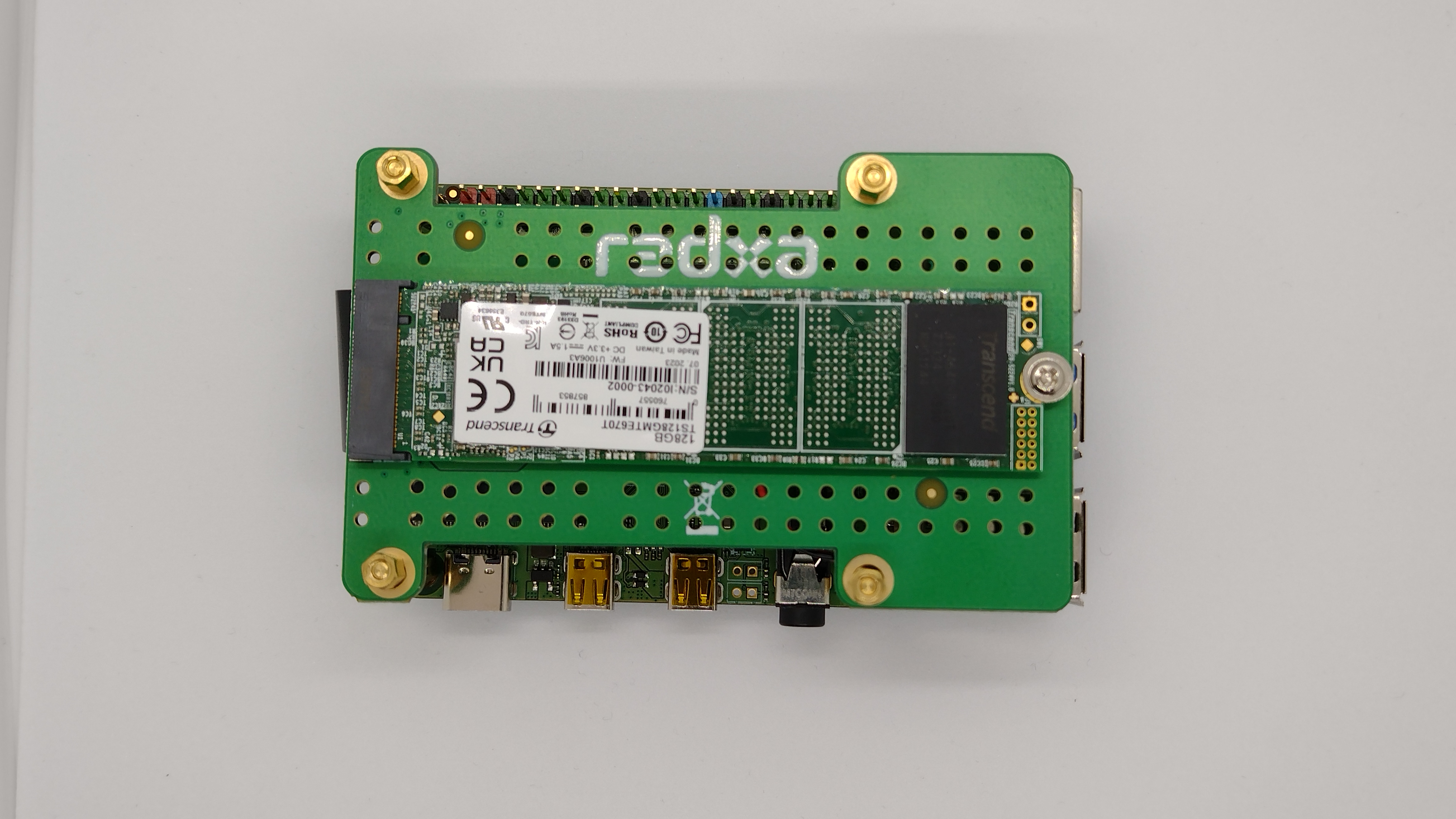
WiFi / Bluetooth
Both boards come with single Gigabit Ethernet ports, but the RPi5 also has a built-in dual-band 802.11ac Wi-Fi® 5 / Bluetooth 5.0 / Bluetooth Low Energy wireless module with a PCB antenna.
If you need WiFi or Bluetooth on the ROCK 5A, the M.2 E-key slot supports dual-band 802.11a/b/g/n/ac/ax Wi-Fi 6 / Bluetooth 5.2 / Bluetooth Low Energy modules. These come with external antennas, so you can easily fit the board into metal enclosures without compromising wireless range.
ROCK 5A with WiFi 6 / Bluetooth 5.2 module and external antennas:
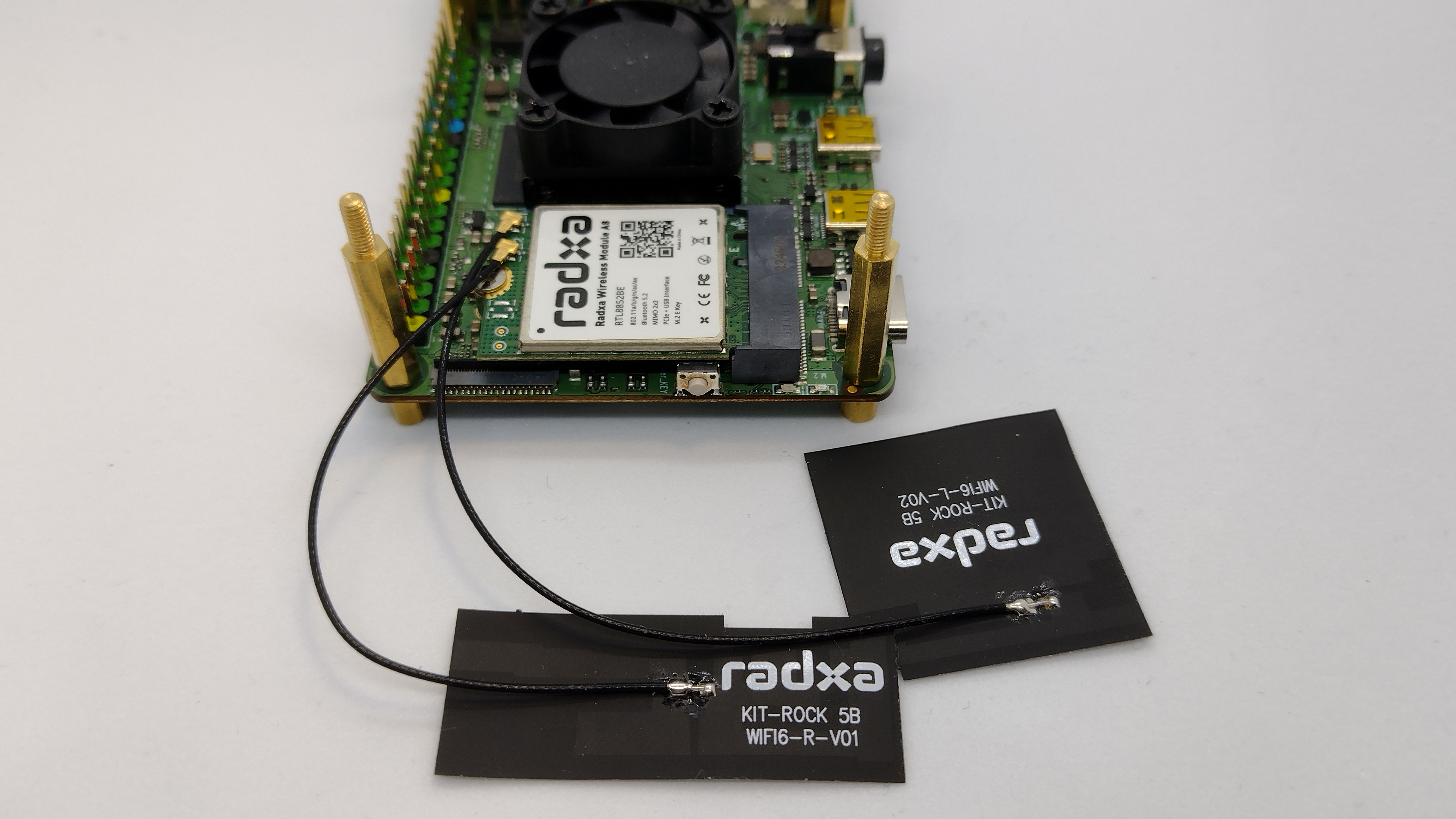
Video – 4K, even on YouTube
RPi5 has a new Broadcom VideoCore VII GPU, which supports the same OpenGL ES 3.1 and Vulkan 1.2, 3D graphics API standards that the ROCK 5A Arm Mali™ G610MC4 GPU uses, so you get fantastic 4Kp60 3D video performance from both boards.

The difference though is that one of the ROCK 5A HDMI adaptors supports up to 8Kp60 resolution, and the Mali GPU can decode H.265, H.264 and VP9 used by YouTube for 4K and higher video content.
Meanwhile, the RPi5 only supports H265 hardware decoding. This means it can only playback 1080p videos in the browser.
This may not be that noticeable on smaller monitors, but the larger the display, the greater the clarity of using 4K or 8K resolution becomes. An important factor if you are using the boards for Digital Signage or Media Centres.
You really need to see the difference in real life, but here are a couple of clips from WebGL samples showing the ROCK 5A can run at 60fps compared to the best performance of the RPi5 at just over 30fps.
RPi5 WebGL Aquarium – 1000 fish at ~30pfs:
RPi5 WebGL Aquarium – 1000 fish at ~60pfs:
Operating Systems

Both boards support a variety of OSs, so there’s always something to meet your needs if you’re prepared to go outside official support.
RPi5 officially supports just PiOS, which is a specialised derivative of Debian. The best thing is it’s the most recent stable version, Bookworm and comes with a 6.1 Linux kernel.
Radxa supports Debian, Ubuntu Server and Android 12. They use the older Debian Bullseye and have the well-proven kernel 5.10. If you need a more recent version, there’s a specialised build tool where you can build the latest and greatest, but it’s technical.
It’s the tool Radxa uses for building their own OS and is constantly updated, with a fast response to any issues raised. You can access the Radxa build tool here.
Desktops
KDE is the default desktop on the ROCK 5A. This is a modern, fully functional environment with all the system administration tools you could need without having to resort to the command line if you don’t want to.
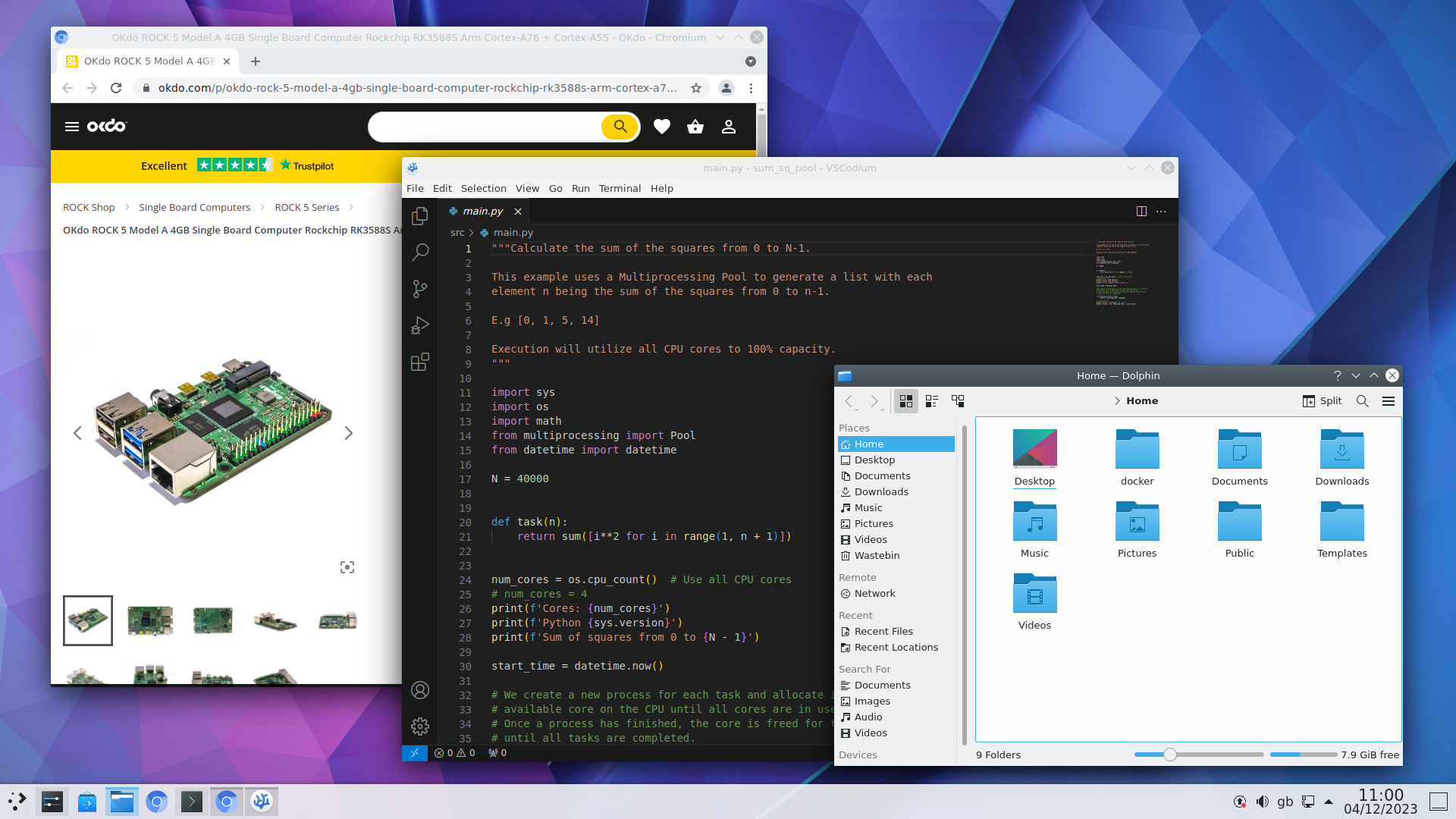
Xfce desktop, the default on the RPi5, is a fine, lightweight environment that is suited to less powerful processors.
You can install KDE onto the RPi5, and it runs well on both boards, but it’s not straightforward to install on the RPi5 unless you can use the command line.
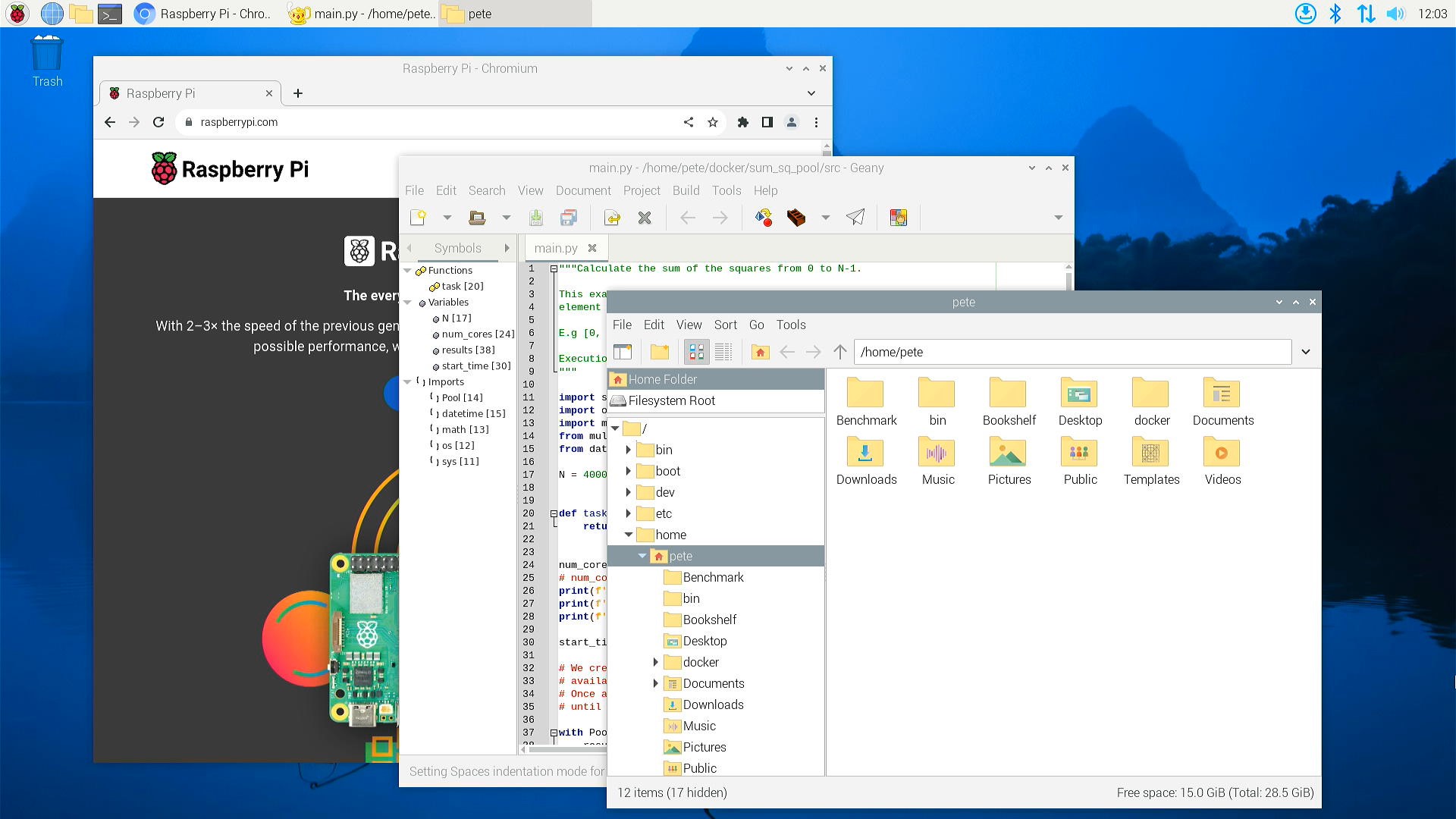
NPU – AI / ML
The last thing I want to mention is AI / ML capability – a hot topic.
Both boards are fast enough to run a lot of non-hardware accelerated Machine Learning applications like OpenCV, which I’ve been testing. This uses the CPU for object detection and inferencing.
ROCK 5A gesture recognition:

If you need to do very fast object classification and detection of live video streams, like number plate recognition or people and vehicle tracking, you will need to use dedicated hardware acceleration.
This can be added to the RPi5 with TPU accelerators like the Coral Board as an add-on, but that’s not ideal due to the performance hit.
The ROCK 5A has a built-in NPU unit in its Rockchip RK3588S CPU, capable of up to 6 TOPS (Coral is 4 TOPS) with support for PyTorch, TensorFlow, Caffe, ONNX and YOLO.

These are all frameworks for building deep learning models, which is a type of machine learning that’s commonly used in applications like image recognition and language processing.
Radxa provides the SDK for accessing the NPU in the Rockchip RK3588S with examples for the above frameworks here.
Summary
If you’re an SBC enthusiast like me, you’ll enjoy working with both the RPi5 and ROCK 5A boards as they’re at the top of their game.
The Raspberry Pi is cheaper, but it’s built to a cost, whereas the ROCK 5A is built for performance and has everything and more that you’d expect from a next-gen board.
As they say in the UK, “You pays your money and you takes your choice”.
Pete Milne
Technical References


Let’s invent the future together
What’s your challenge? From augmented reality to machine learning and automation, send us your questions, problems or ideas… we have the solution to help you design the world. Get in touch today.

